Abstract
The present article describes the stages of website development business process in the IT company, identifies the main shortcomings and problems in the structure of the business process through carrying out the analysis. Project management tools have been considered as tools of business process improvement, the criteria for selecting a project management system for implementation in the organization under study have been outlined. We have substantiated the efficiency of the project management system for the business process under study and calculated the indicators of project efficiency before and after management automation in the process of web design. The use of project management tools in improving the studied business process of an IT company is characterized by positive results: increasing the number of projects implemented, increasing the average revenue of projects implemented reducing the average time spent on the project, reducing the average cost of the project and increasing the average profit of projects implemented.
Keywords: Business processIT companymanagementproject implementationwebsite development
Introduction
Ongoing transformation processes in almost all spheres and industries result from increased rates of introduction of new technological developments, reduced life cycle of products, strengthening of digital transformation trends, which requires companies to respond more quickly and flexibly to external "disturbing" factors, dynamically changing customer preferences, and, consequently, constant improvement and adequate management response to changes (Melnikova & Syso, 2007).
Problem Statement
The functional approach to management widespread in Russian companies does not provide a quick response to external changes, slows down the process of making and implementing decisions and provokes a conflict of interests, due to rigid vertical hierarchy of subordination against the background of horizontal organization of business processes (Deming & Guresh, 2011; Demenko et al., 2017; Klochko et al., 2017).
It should be mentioned that there is no optimal management approach, but, in our view, process and project approaches, or their combinatorial use have certain advantages which allow avoiding problems of functional management.
Research Questions
Development of digital technologies and e-business has predetermined the availability of a high-quality and user-friendly website as one of the competitive advantages of both manufactures and sellers (Korshunov & Kroitor, 2019). This makes urgent the issues of management of profile companies' website development since the product quality and timing are the most important evaluation indicators for consumers.
Purpose of the Study
Timely meeting of customer needs for high-quality products requires well-managed and predictable project implementation. This can be achieved through a mechanism built into the processes – a set of project management tools (Deberdieva et al., 2019; Milani & Luciano, 2018). Thus, the research aims at studying the impact of project management tools on the business process of the object under study and proving the feasibility of such improvement measures.
Research Methods
Competitiveness of IT companies providing services in integrated Internet marketing is largely determined by the quality and timing of work, as well as the quality of the customer-oriented approach. Assessment of competitiveness and efficiency of regional IT companies let reveal problems in implementation of the process approach, in particular, the inefficiency of website development process (Figure
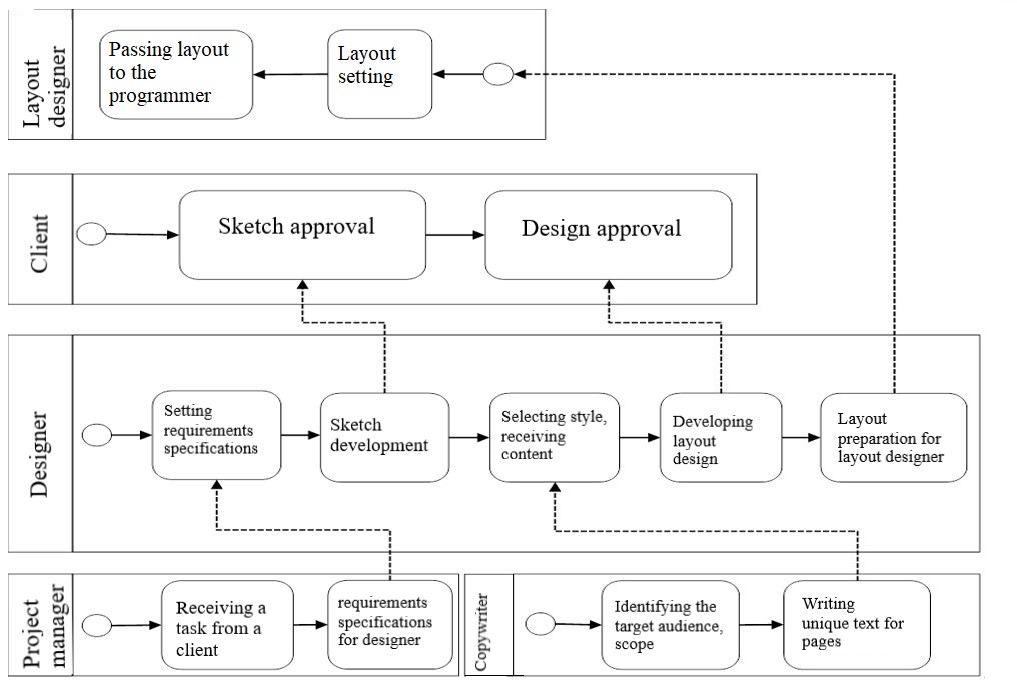
Findings
The most difficult stages of the business process include: site prototyping, design, layout, programming, as well as testing and debugging, each of which has its own unique and non-repeating properties. Each client has different demands for site functioning, which does not allow standardizing programming operations.
Web design often provokes misunderstandings between the designer and the client, which affects work's timing. The stage of testing and debugging is characterized by a number of repeated works. Almost every stage is associated with a "crisis of trust" between the customer and the developer (figure
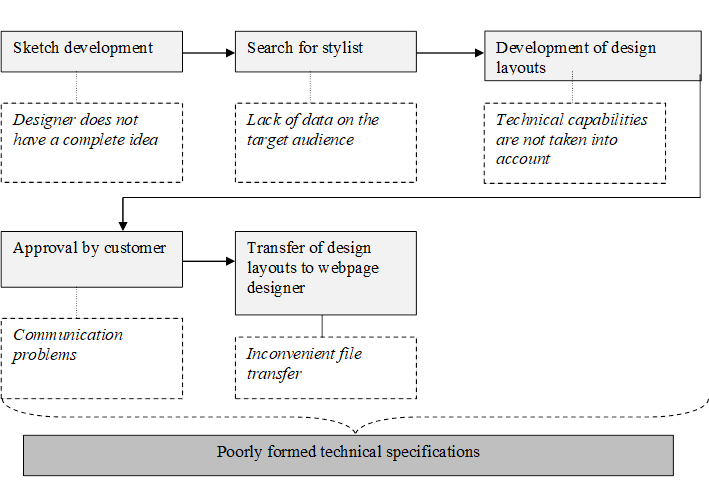
To solve these problems, it is proposed to standardize project management processes by implementing a corporate system of project management, which would allow solving a number of tasks:
providing access to up-to-date information about projects in real time;
organizing joint work of project participants (storage of project documents, integration with other services, chat);
allocating resources (financial, production, human) among projects, taking into account their current status, urgency and priorities, interdependencies and time constraints;
regulating team workload by a project manager, redistributing work among employees.
Choice of a project management system is primarily due to the company needs, but redundant capabilities and functionality of the system may most likely remain non-demanded (Innovations in management of regional and industry development, 2015). In this regard, we shall define the main criteria for selecting a project management system for the web studio of the studied organization (Table
In addition to the above criteria, it is necessary to pay attention to the presence of recurrent tasks, reminders, possibility of dividing project into tasks and subtasks, resuming completed tasks, task filtering, constructing the hierarchical system and the system of distribution of access rights to tasks, scheduling working time, calculating labor costs, etc.
Since the tools used in process management do not allow solving the tasks of improving the website design business process, it is proposed to apply the tools of project management. To this end, we shall correlate the tasks and their solutions using the tools of the Planfix project management system (Table
Applying project management tools is not limited to web design tasks. We have considered one sample business process, but in practice, the advantages of using the project management system are much wider.
Today, there are no large-scale estimates of efficiency of using project management information system in Russian practice, since few companies actually use such full-featured systems. A similar study has been conducted by the Institute of project management of the USA (PMI), which has shown that the use of such systems increases the efficiency of project performance in many times as compared to companies that had not implemented this approach (Information systems and project management tools).
Implementation of the Planfix project management system is expected to reduce the number of tasks under projects by 22.2 % (Figure
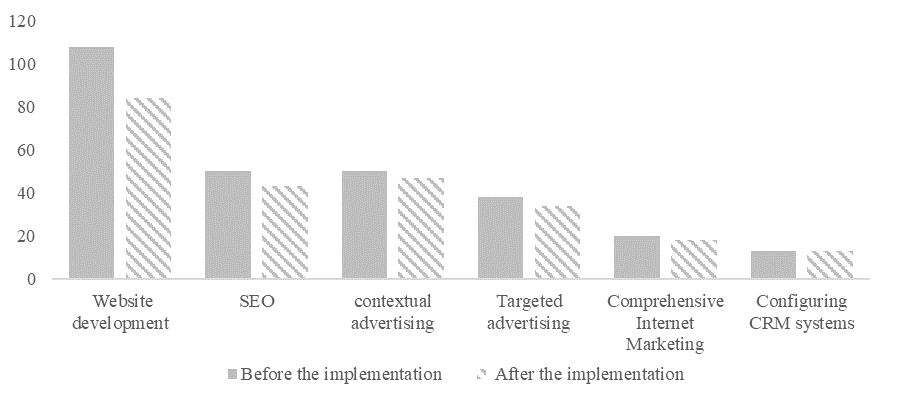
This result is achieved by eliminating routine tasks and automating them. In the considered web studio, there are tasks on clarifying the current status of the project, current workload of employees, customer relations and project modifications. The Planfix project management system automates these tasks and provides an opportunity to view all these data. Using the Gantt chart, the Kanban board, and remote employee reporting will reduce the task scheduling time by 30%.
Conclusion
Reducing the number of tasks will reduce the time spent by employees on the project as a whole. As a result, web Studio will be able to accomplish more projects per month. The number of completed projects is expected to increase by 15 projects per year (RBC, 2018).
Moreover, reducing the time spent on project implementation will reduce the average cost of each of project's stages and increase revenue by 18%. All calculations are made at constant revenue for one project (Figure
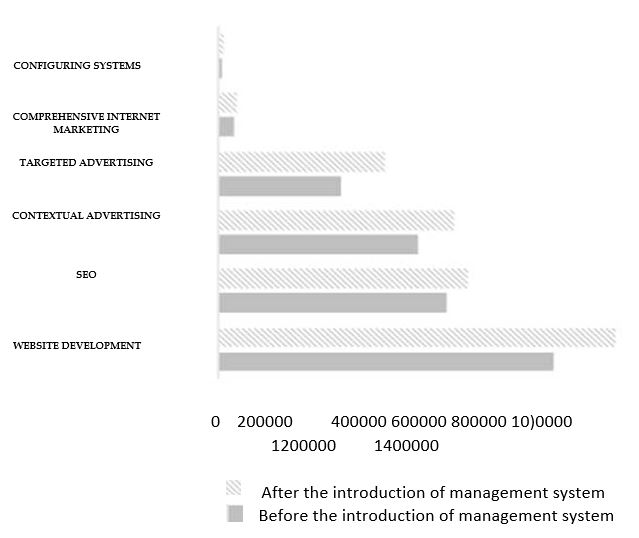
The diagram shows revenue growth in various areas, except for CRM systems configuration (Suzdalova et al., 2017). This is due to the fact that the business process of this area is fully described, and it is characterized by a small number of tasks. Only one programmer is responsible for this work, and the whole process is almost always completely identical.
The method of discounting cash flows is used to account for changes in the value of money over time.
Internal and external factors of influence are evaluated to assess the risks associated with the project implementation (Table
Neutralizing this risk requires carrying out the following activities: increase of wages and bonuses for correct work in the management system; monitoring of feedback from employees; adjustment of the management system according to the feedback. External factors include the following: a sharp increase in tariffs for the Planfix project management system (Table
Investment costs will make 64 000 rubles, of which the project initiator's funds amount to 64 000 rubles. After implementation of the project management system, the annual subscription to the Planfix system in the amount of 17 280 rubles should be attributed to the fixed costs.
The project of introducing the Planfix project management system in the web studio can be considered to be effective (Minin et al., 2019). The expected indicators of using the project management system have been compiled on the basis of reporting of the company under study and review of effectiveness of using management systems by the Institute of project management of the USA, as well adjustments made by the director of web-studio. The diagram shows the expected indicators of the web studio after implementation of the project management system (Figure
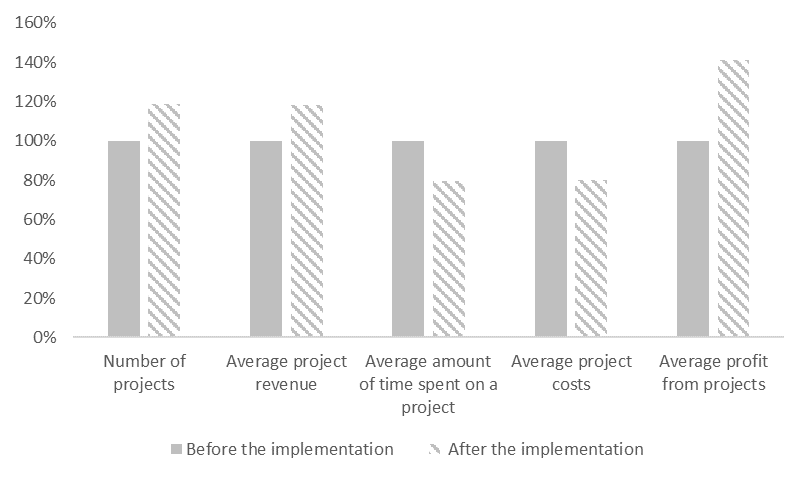
Summarizing the abovesaid, it can be concluded that the use of project management tools in improving the studied business process of an IT company is characterized by positive results: increasing the number of projects implemented, increasing the average revenue of projects implemented by 18%, reducing the average time spent on the project by 21%, reducing the average cost of the project by 20% and increasing the average profit of projects implemented by 41%. Thus, implementation of the project management system in the company under study allows solving a number of problems inherent in each stage of the business process.
References
- Innovations in management of regional and industry development: collection of scientific works: conference proceedings. (2015). TSOGU Publ.
- Deberdieva, E. M., Vechkasova, M. V., Golikava, H. S., Borisova, A. A., & Lysenko, A. F. (2019). Experience in the management of business processes with the use of digital technologies by russian companies of a petrochemical complex. IOP Conf. Series: Materials Science and Engineering, 483, 012066.
- Demenko, O. G., Makarova, I. G., & Konysheva, M. V. (2017). The origin and development of municipal self-government in Russia. Man in India, 97(20), 381-390.
- Deming, U. E., & Guresh, T. (2011). A Way out of the crisis. New paradigm of people, systems and processes management. Alpina Publisher.
- Information systems and project management tools. http://aniri.flatrate.ru/Reading/Reading/Менеджмент/конспекты%20лекций/15-PRM-04.pdf
- Klochko, S. N., Nalbandian, N. A., & Tsvetkova, D. A. (2017). Problems and prospects of economics and management. Proceedings of the 6th International Scientific Conference, St. Petersburg, December 2017. https://moluch.ru/conf/econ/archive/263/13344/
- Korshunov, G. P., & Kroitor, S. N. (2019). Problem of the level and quality of life in the era of digitalization. Logos et Praxis, 18(2), 24-38. https://doi.org/10.15688/lp.jvolsu.2019.2.3
- Melnikova, E. E., & Syso, T. N. (2007). Methods used in business process management. Vestn. NGU. Series: Social and economic sciences,1, 47–53.
- Milani, F., & Luciano, G. B. (2018). Blockchain and Principles of Business Process Re-Engineering for Process Innovation. https://arxiv.org/pdf/1806.03054.pdf
- Minin, M. G., Politsinskaya, E. V., & Lizunkov, V. G. (2019). Readiness of technical university students to entrepreneurship activity. Higher Education in Russia, 28(10), 83-95.
- Politsinskaya, E., Lizunkov, V., & Ergunova, O. (2019). Organization of student project based activities through individual learning routes. International Journal of Emerging Technologies in Learning, 14(11), 186-193.
- RBC. (2018, October 16). Step into the future of RBC. http://t.rbcplus.ru/news/5ba8b6e97a8aa9587ebd995e?ruid=uUjlA1vlAbt3I0aOAwqBAg
- Rodtsevich, O. N. (2015). Process Management Tools. http://edoc.bseu.by:8080/bitstream/edoc/58783/1/Rodtsevich_O._N._42_50.pdf
- Suzdalova, M. A., Lizunkov, V. G., Malushko, E. Yu., Sytina, N. A., & Medvedev, V. E. (2017). Innovative forms of partnership in development and implementation of university-business cooperation. The European Proceedings of Social and Behavioural Sciences EpSBS, XIX, 450-455.
Copyright information

This work is licensed under a Creative Commons Attribution-NonCommercial-NoDerivatives 4.0 International License.
About this article
Publication Date
28 December 2020
Article Doi
eBook ISBN
978-1-80296-098-3
Publisher
European Publisher
Volume
99
Print ISBN (optional)
-
Edition Number
1st Edition
Pages
1-1040
Subjects
Multicultural context, learning environment, modern society, personality formation, informatization of the society, economics and law system of the region
Cite this article as:
Deberdieva, E. M., Vechkasova, M. V., Malyutina, T. V., & Borisova, A. A. (2020). Management Of Website Development Business Process In The It Company. In N. L. Shamne, S. Cindori, E. Y. Malushko, O. Larouk, & V. G. Lizunkov (Eds.), Individual and Society in the Modern Geopolitical Environment, vol 99. European Proceedings of Social and Behavioural Sciences (pp. 229-238). European Publisher. https://doi.org/10.15405/epsbs.2020.12.04.27

